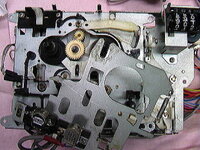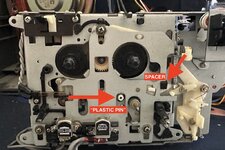I've got an M90 that works pretty well with the exception of playing a cassette. When I press play, the solenoid thunks, the head and pinch roller rise up, a tiny bit of sound can be heard, and then the head and pinch roller retract and the deck stops. This happens very quickly.
Fast Forward and Rewind work well.
Belts have been replaced (including the tape counter)
I've checked (with a multimeter!) and replaced the fusible resistors.
I've verified the reflective gear is in place, and a red light is visible on it that turns off when the deck stops.
No gears are cracked or broken that I can see.
I've read many of the posts here, but none seem to be related to this issue I am seeing. I feel like most everything that I can inspect is working and/or set to spec. I appreciate any response.
Fast Forward and Rewind work well.
Belts have been replaced (including the tape counter)
I've checked (with a multimeter!) and replaced the fusible resistors.
I've verified the reflective gear is in place, and a red light is visible on it that turns off when the deck stops.
No gears are cracked or broken that I can see.
I've read many of the posts here, but none seem to be related to this issue I am seeing. I feel like most everything that I can inspect is working and/or set to spec. I appreciate any response.





